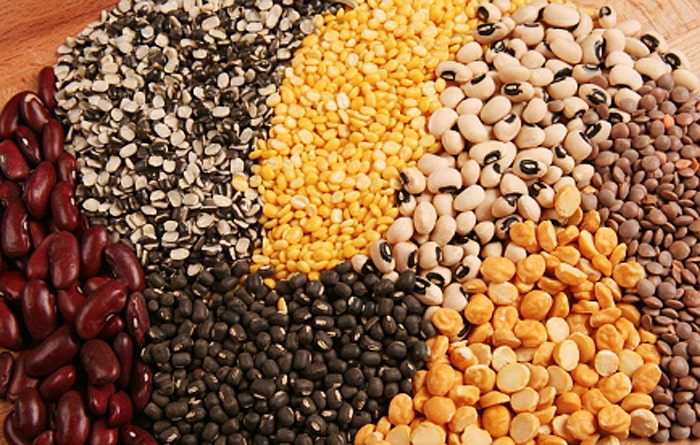You have heard numerous times about the many health benefits of beans – they’re rich in fiber and antioxidants, yet low in fat – but you may be wondering how you can add them to your daily diet beyond the obvious chili or bean salad. Why not take a little journey around the world to explore bean dishes from other cultures? It may just inspire you to experiment with some new flavors and discover new bean-rich favorites!

Top 5 Bean Dishes from Around the World
- Hielem: Originating from Tunisia, a country in northern Africa, hielem is a hearty soup made with beans, swiss chard and noodles. The soup usually includes a combination of lima beans (sometimes called butter beans) and garbanzo beans (chickpeas). Just before serving, the soup is topped with a spoonful of harissa, a paste made with fresh chilies, olive oil, and herbs. Common seasonings for the soup include onion, celery, parsley, and tomato paste. For harissa, spices you can use include fresh hot red peppers, mint leaves, garlic, cumin, coriander, and cayenne pepper. The noodles that work best in this recipe are thin ones; try angel hair pasta or thin egg noodles.
- Cholent, Feijoada, and Cassoulet: These are essentially bean-rich stews simmered with meat or sausages, each a from different culture: cholent is a Jewish stew, feijoada hails from Brazil, and cassoulet is French. Feijoada uses black beans simmered with preserved meats, sausages and pork. In the absence of exotic ingredients, you can use corned beef, chorizo sausage (or any other sweet sausage of your choice), and pork ribs (adventurous types may use pig’s feet). The French cassoulet uses a generous amount of white beans simmered with goose or lamb and mutton, as well as certain sausages (depending on the region). The Jewish cholent uses various kinds of beans simmered with beef and pearl barley. The main seasonings are paprika and garlic, and whole eggs (in their shells) are often added to simmer together with the beans, meat, and seasonings. The eggs absorb the flavor of the broth.
- Asian Mung Bean Desserts: Beans in desserts? You bet! In many Asian cuisines, there are two beans that are often enjoyed in sweet desserts: mung bean and red azuki bean. Sprouted mung beans are the Chinese bean sprouts often found in stir-fry or noodle dishes. Both beans are both quite tiny (about the size of a grain of cooked pearl barley). A common way to serve them as dessert is to cook them in water with sugar, slices of fresh ginger, and pandan leaves, and then serve the resulting soupy mixture (either hot or cold) with a few spoonfuls of coconut milk as a topping. Or, if the mushy texture doesn’t appeal to you, steam the beans to cook them, then serve with a simple vanilla syrup topped with a few slices of Chinese fried doughnuts. A pastry made with sweet bean paste is also a popular item; pretty much all Southeast Asian cuisines have a version of this dessert. If you have never tried these two beans, the main difference between the two is texture. Mung bean has a grainier mouthfeel (less mushy) than red bean.
- Gigandes Plaki: Many of us associate Greek food with souvlaki skewers, deep-fried calamari, or gyros. But another staple is gigandes plaki, which is essentially the Greek version of baked beans. The traditional version calls for the giant white bean, but you can substitute frozen lima or butter beans. The beans are baked in the oven with tomatoes, onion, parsley, and garlic. Some versions include additional vegetables such as celery, carrots, or roasted red peppers. Cured meat or sausages are sometimes added.
- Mujaddara or Mejadra: One of the most popular Middle Eastern dishes is falafel (deep-fried vegetarian patties made with chickpeas). Another staple among many Middle Eastern countries is mujaddara, which is essentially lentils cooked with rice or cracked wheat. The main feature of the dish is that it uses copious amounts of well-caramelized onion (most recipes encourage you to brown the onion as much as possible, even scorching some bits) to flavor the broth that cooks the lentils and rice. Add cumin while the onion is browning, and squeeze fresh lemon juice on just before eating.
The Bottom Line
Beans are truly unsung heroes – they are nutritious, cheap, and easy to cook with. Most dried beans only require that you pre-soak them the night before cooking, and they do great in slow-cooker dishes. By taking some inspiration from other cultures, you may discover new vegetarian staples to add to your family meal rotation.
Alumni: University of California, Berkeley – Sofia believes in bringing back fun and pleasure into everyday eating. She loves cooking, and is constantly experimenting with ingredients, creating recipes and trying them out on family and friends. Her latest interest lies in finding realistic and practical ways of environmentally-friendly food/eating habits.


